ECU TOYOTA AURIS 2012 Owners Manual (in English)
[x] Cancel search | Manufacturer: TOYOTA, Model Year: 2012, Model line: AURIS, Model: TOYOTA AURIS 2012Pages: 750, PDF Size: 20.05 MB
Page 3 of 750
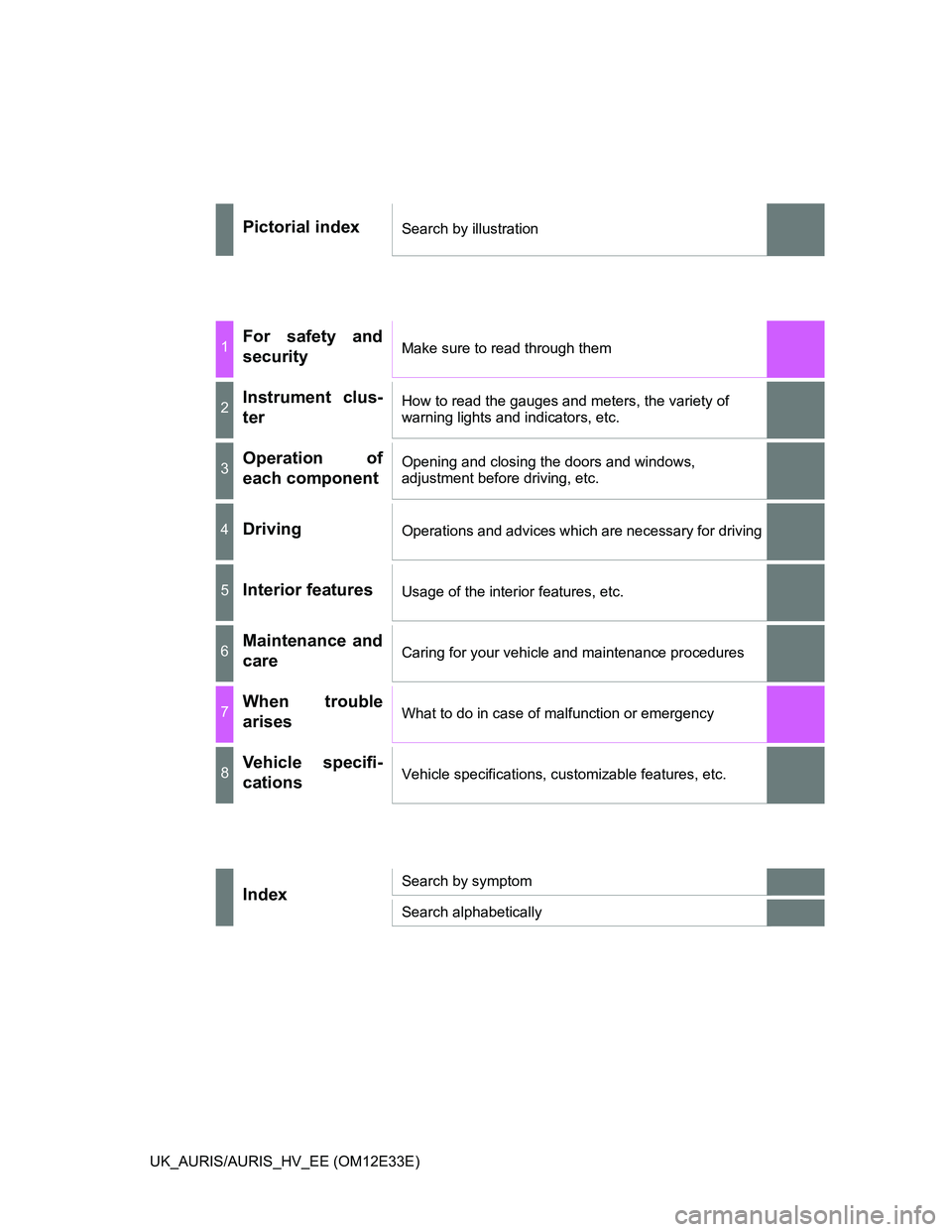
UK_AURIS/AURIS_HV_EE (OM12E33E)
Pictorial indexSearch by illustration
1For safety and
securityMake sure to read through them
2Instrument clus-
terHow to read the gauges and meters, the variety of
warning lights and indicators, etc.
3Operation of
each componentOpening and closing the doors and windows,
adjustment before driving, etc.
4DrivingOperations and advices which are necessary for driving
5Interior featuresUsage of the interior features, etc.
6Maintenance and
careCaring for your vehicle and maintenance procedures
7When trouble
arisesWhat to do in case of malfunction or emergency
8Vehicle specifi-
cationsVehicle specifications, customizable features, etc.
IndexSearch by symptom
Search alphabetically
Page 4 of 750
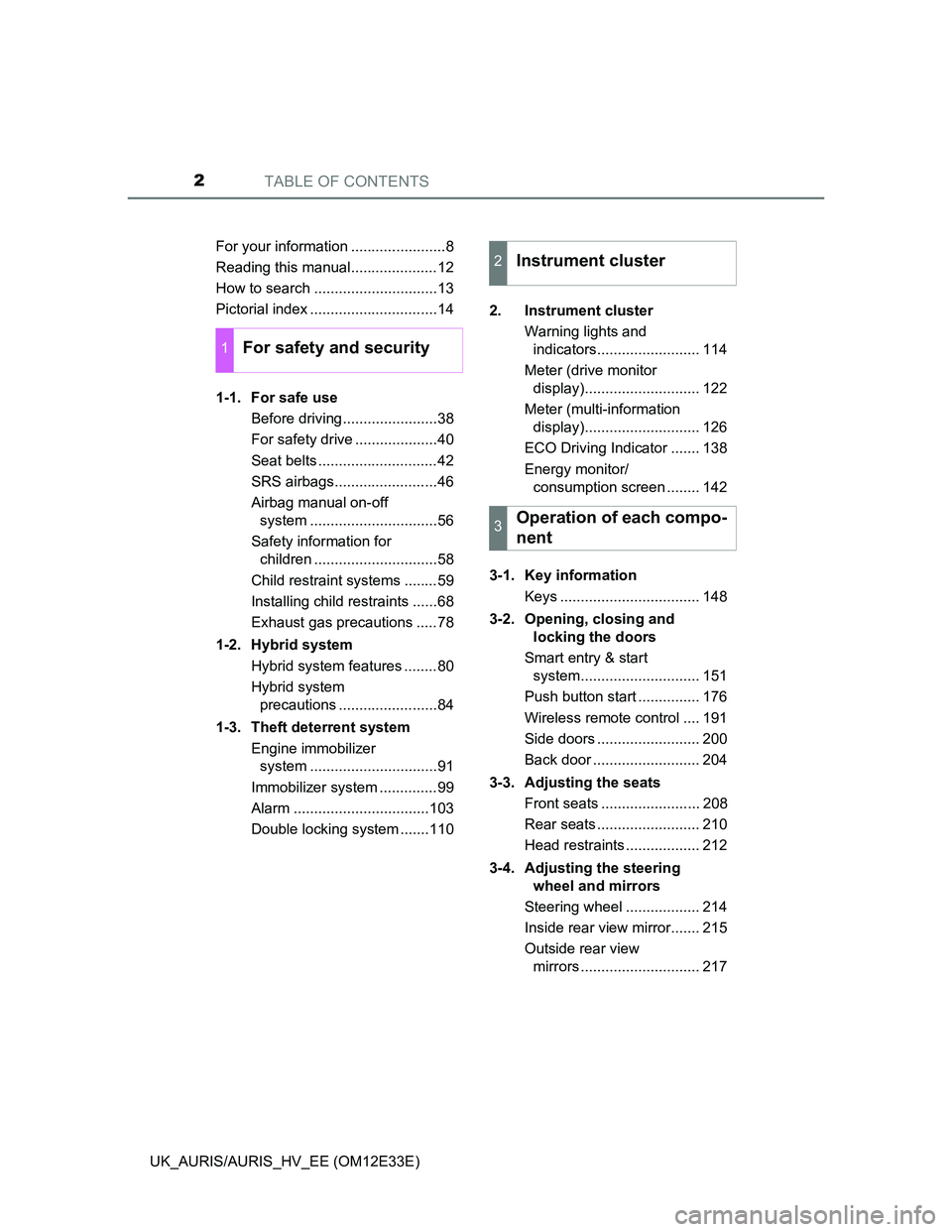
TABLE OF CONTENTS2
UK_AURIS/AURIS_HV_EE (OM12E33E)For your information .......................8
Reading this manual.....................12
How to search ..............................13
Pictorial index ...............................14
1-1. For safe use
Before driving.......................38
For safety drive ....................40
Seat belts .............................42
SRS airbags.........................46
Airbag manual on-off
system ...............................56
Safety information for
children ..............................58
Child restraint systems ........59
Installing child restraints ......68
Exhaust gas precautions .....78
1-2. Hybrid system
Hybrid system features ........80
Hybrid system
precautions ........................84
1-3. Theft deterrent system
Engine immobilizer
system ...............................91
Immobilizer system ..............99
Alarm .................................103
Double locking system .......1102. Instrument cluster
Warning lights and
indicators......................... 114
Meter (drive monitor
display)............................ 122
Meter (multi-information
display)............................ 126
ECO Driving Indicator ....... 138
Energy monitor/
consumption screen ........ 142
3-1. Key information
Keys .................................. 148
3-2. Opening, closing and
locking the doors
Smart entry & start
system............................. 151
Push button start ............... 176
Wireless remote control .... 191
Side doors ......................... 200
Back door .......................... 204
3-3. Adjusting the seats
Front seats ........................ 208
Rear seats ......................... 210
Head restraints .................. 212
3-4. Adjusting the steering
wheel and mirrors
Steering wheel .................. 214
Inside rear view mirror....... 215
Outside rear view
mirrors ............................. 217
1For safety and security
2Instrument cluster
3Operation of each compo-
nent
Page 39 of 750
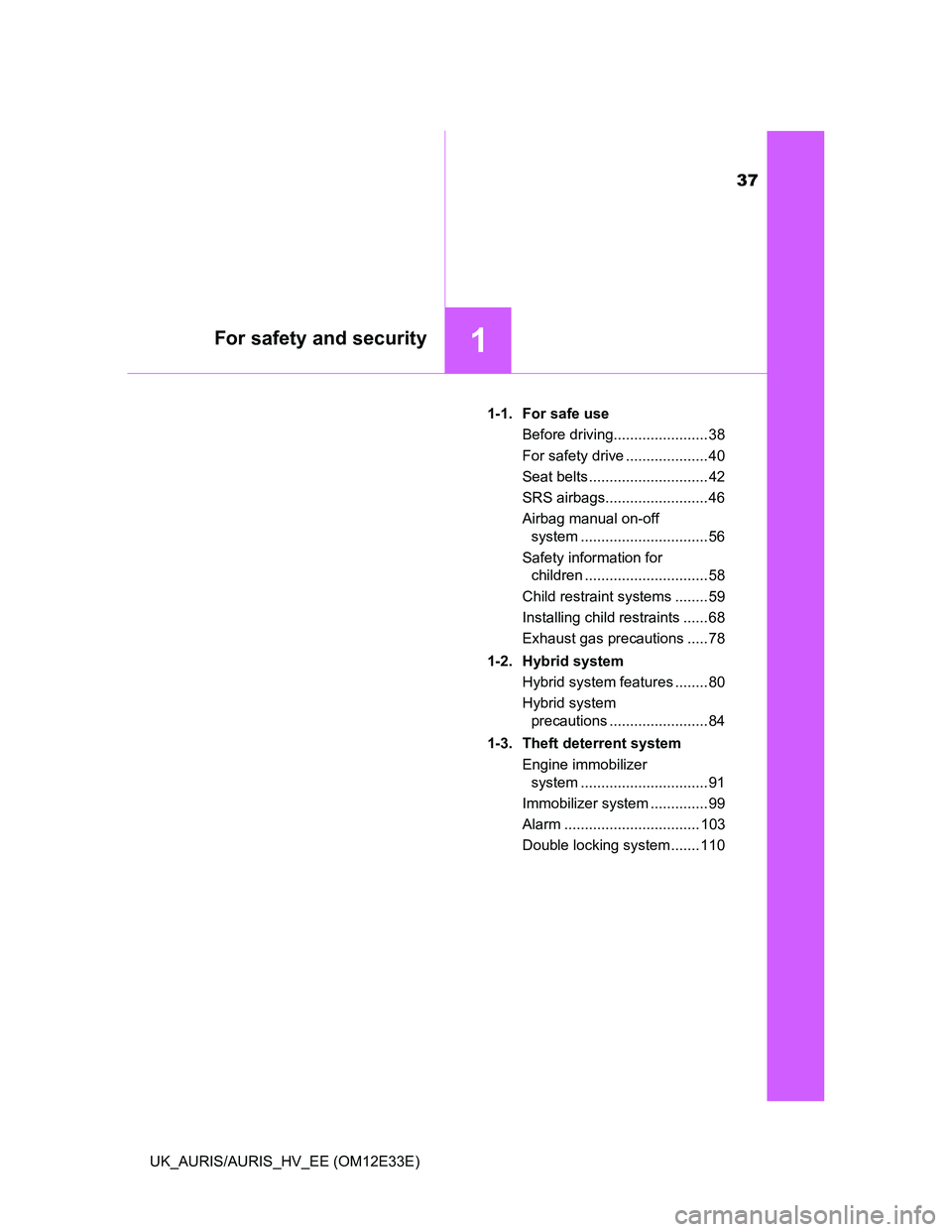
37
1For safety and security
UK_AURIS/AURIS_HV_EE (OM12E33E)1-1. For safe use
Before driving....................... 38
For safety drive .................... 40
Seat belts ............................. 42
SRS airbags......................... 46
Airbag manual on-off
system ............................... 56
Safety information for
children .............................. 58
Child restraint systems ........ 59
Installing child restraints ...... 68
Exhaust gas precautions ..... 78
1-2. Hybrid system
Hybrid system features ........ 80
Hybrid system
precautions ........................ 84
1-3. Theft deterrent system
Engine immobilizer
system ............................... 91
Immobilizer system .............. 99
Alarm ................................. 103
Double locking system ....... 110
Page 40 of 750
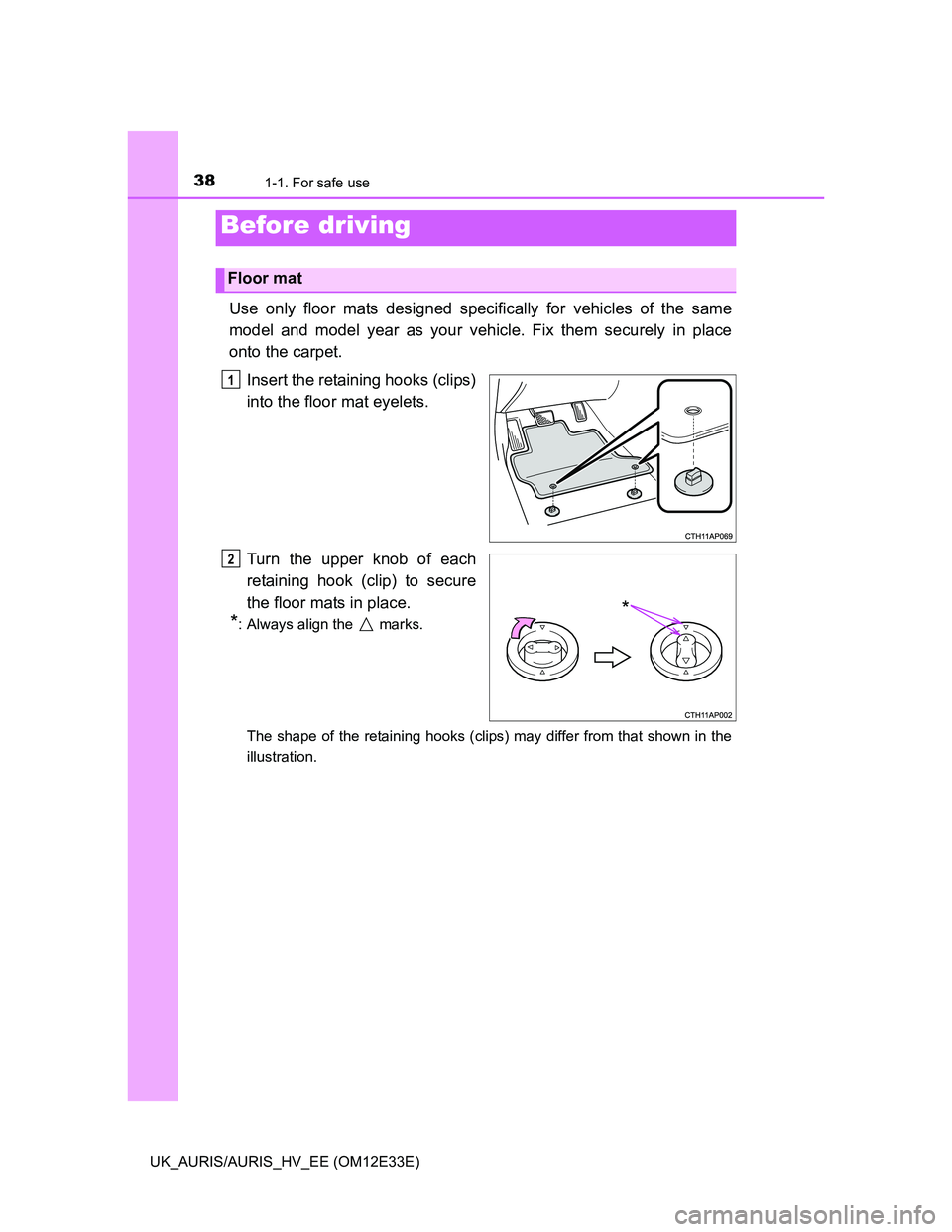
38
UK_AURIS/AURIS_HV_EE (OM12E33E)
1-1. For safe use
Use only floor mats designed specifically for vehicles of the same
model and model year as your vehicle. Fix them securely in place
onto the carpet.
Insert the retaining hooks (clips)
into the floor mat eyelets.
Turn the upper knob of each
retaining hook (clip) to secure
the floor mats in place.
*: Always align the marks.
The shape of the retaining hooks (clips) may differ from that shown in the
illustration.
Before driving
Floor mat
1
*
2
Page 41 of 750
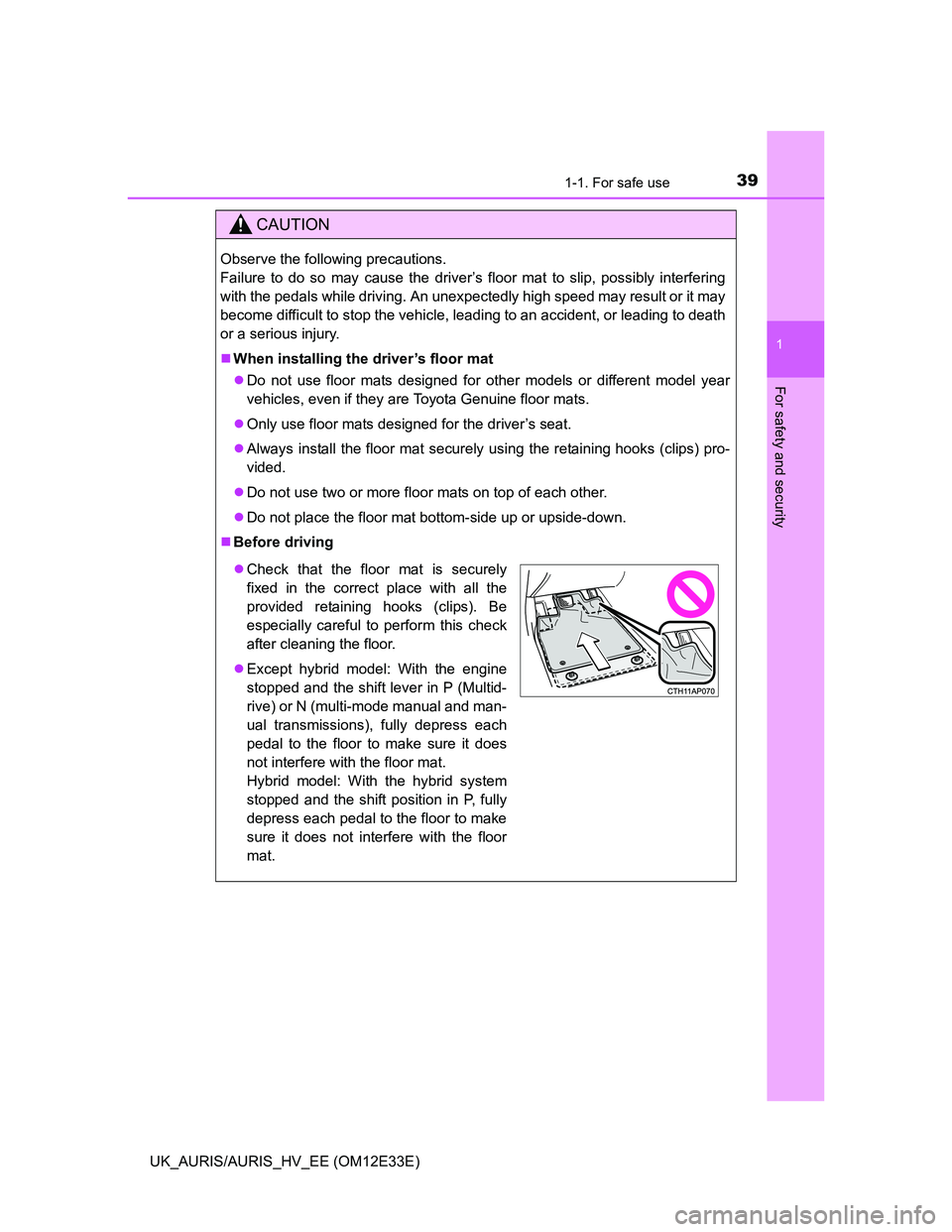
391-1. For safe use
1
For safety and security
UK_AURIS/AURIS_HV_EE (OM12E33E)
CAUTION
Observe the following precautions.
Failure to do so may cause the driver’s floor mat to slip, possibly interfering
with the pedals while driving. An unexpectedly high speed may result or it may
become difficult to stop the vehicle, leading to an accident, or leading to death
or a serious injury.
When installing the driver’s floor mat
Do not use floor mats designed for other models or different model year
vehicles, even if they are Toyota Genuine floor mats.
Only use floor mats designed for the driver’s seat.
Always install the floor mat securely using the retaining hooks (clips) pro-
vided.
Do not use two or more floor mats on top of each other.
Do not place the floor mat bottom-side up or upside-down.
Before driving
Check that the floor mat is securely
fixed in the correct place with all the
provided retaining hooks (clips). Be
especially careful to perform this check
after cleaning the floor.
Except hybrid model: With the engine
stopped and the shift lever in P (Multid-
rive) or N (multi-mode manual and man-
ual transmissions), fully depress each
pedal to the floor to make sure it does
not interfere with the floor mat.
Hybrid model: With the hybrid system
stopped and the shift position in P, fully
depress each pedal to the floor to make
sure it does not interfere with the floor
mat.
Page 43 of 750
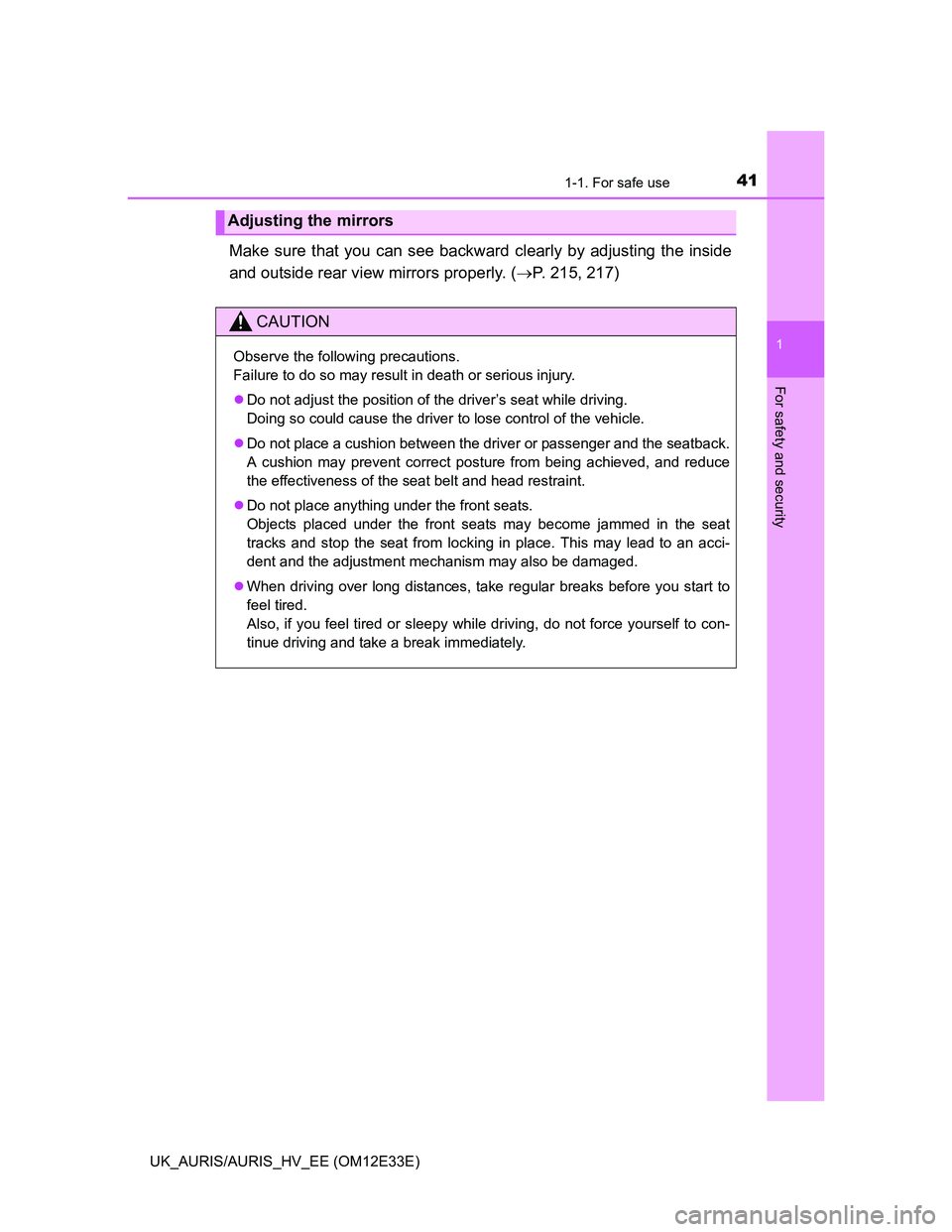
411-1. For safe use
1
For safety and security
UK_AURIS/AURIS_HV_EE (OM12E33E)
Make sure that you can see backward clearly by adjusting the inside
and outside rear view mirrors properly. (P. 215, 217)
Adjusting the mirrors
CAUTION
Observe the following precautions.
Failure to do so may result in death or serious injury.
Do not adjust the position of the driver’s seat while driving.
Doing so could cause the driver to lose control of the vehicle.
Do not place a cushion between the driver or passenger and the seatback.
A cushion may prevent correct posture from being achieved, and reduce
the effectiveness of the seat belt and head restraint.
Do not place anything under the front seats.
Objects placed under the front seats may become jammed in the seat
tracks and stop the seat from locking in place. This may lead to an acci-
dent and the adjustment mechanism may also be damaged.
When driving over long distances, take regular breaks before you start to
feel tired.
Also, if you feel tired or sleepy while driving, do not force yourself to con-
tinue driving and take a break immediately.
Page 45 of 750
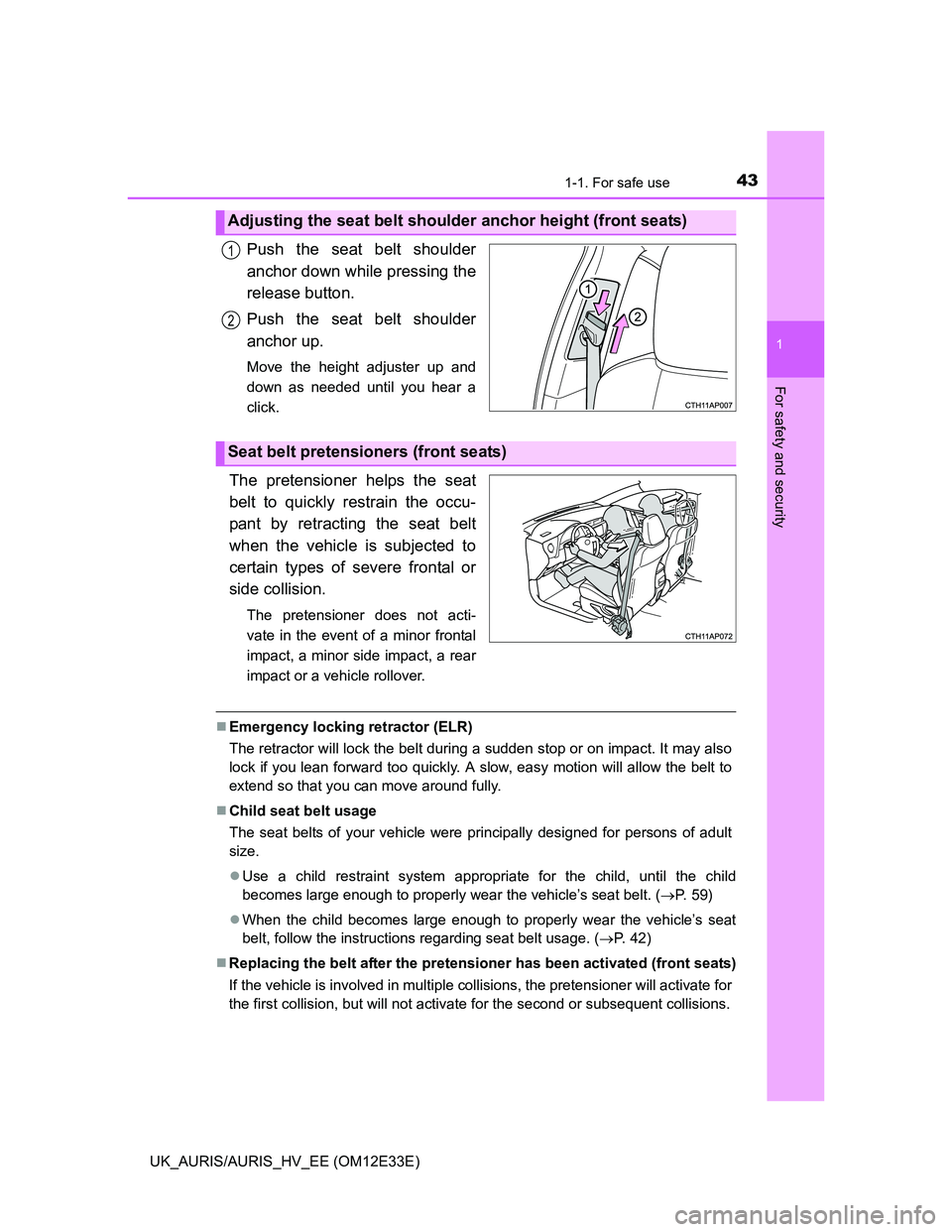
431-1. For safe use
1
For safety and security
UK_AURIS/AURIS_HV_EE (OM12E33E)
Push the seat belt shoulder
anchor down while pressing the
release button.
Push the seat belt shoulder
anchor up.
Move the height adjuster up and
down as needed until you hear a
click.
The pretensioner helps the seat
belt to quickly restrain the occu-
pant by retracting the seat belt
when the vehicle is subjected to
certain types of severe frontal or
side collision.
The pretensioner does not acti-
vate in the event of a minor frontal
impact, a minor side impact, a rear
impact or a vehicle rollover.
Emergency locking retractor (ELR)
The retractor will lock the belt during a sudden stop or on impact. It may also
lock if you lean forward too quickly. A slow, easy motion will allow the belt to
extend so that you can move around fully.
Child seat belt usage
The seat belts of your vehicle were principally designed for persons of adult
size.
Use a child restraint system appropriate for the child, until the child
becomes large enough to properly wear the vehicle’s seat belt. (P. 59)
When the child becomes large enough to properly wear the vehicle’s seat
belt, follow the instructions regarding seat belt usage. (P. 42)
Replacing the belt after the pretensioner has been activated (front seats)
If the vehicle is involved in multiple collisions, the pretensioner will activate for
the first collision, but will not activate for the second or subsequent collisions.
Adjusting the seat belt shoulder anchor height (front seats)
1
2
Seat belt pretensioners (front seats)
Page 47 of 750
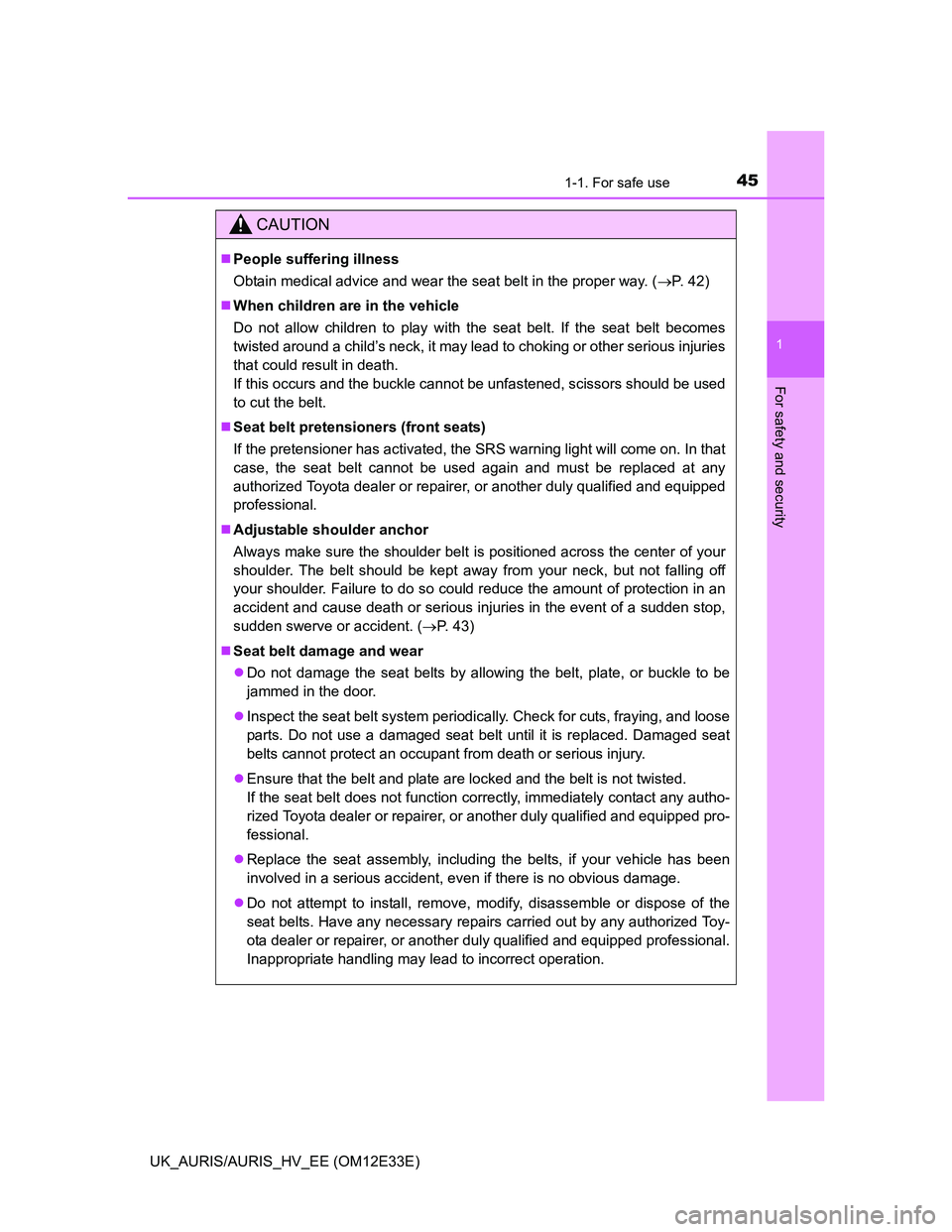
451-1. For safe use
1
For safety and security
UK_AURIS/AURIS_HV_EE (OM12E33E)
CAUTION
People suffering illness
Obtain medical advice and wear the seat belt in the proper way. (P. 42)
When children are in the vehicle
Do not allow children to play with the seat belt. If the seat belt becomes
twisted around a child’s neck, it may lead to choking or other serious injuries
that could result in death.
If this occurs and the buckle cannot be unfastened, scissors should be used
to cut the belt.
Seat belt pretensioners (front seats)
If the pretensioner has activated, the SRS warning light will come on. In that
case, the seat belt cannot be used again and must be replaced at any
authorized Toyota dealer or repairer, or another duly qualified and equipped
professional.
Adjustable shoulder anchor
Always make sure the shoulder belt is positioned across the center of your
shoulder. The belt should be kept away from your neck, but not falling off
your shoulder. Failure to do so could reduce the amount of protection in an
accident and cause death or serious injuries in the event of a sudden stop,
sudden swerve or accident. (P. 43)
Seat belt damage and wear
Do not damage the seat belts by allowing the belt, plate, or buckle to be
jammed in the door.
Inspect the seat belt system periodically. Check for cuts, fraying, and loose
parts. Do not use a damaged seat belt until it is replaced. Damaged seat
belts cannot protect an occupant from death or serious injury.
Ensure that the belt and plate are locked and the belt is not twisted.
If the seat belt does not function correctly, immediately contact any autho-
rized Toyota dealer or repairer, or another duly qualified and equipped pro-
fessional.
Replace the seat assembly, including the belts, if your vehicle has been
involved in a serious accident, even if there is no obvious damage.
Do not attempt to install, remove, modify, disassemble or dispose of the
seat belts. Have any necessary repairs carried out by any authorized Toy-
ota dealer or repairer, or another duly qualified and equipped professional.
Inappropriate handling may lead to incorrect operation.
Page 49 of 750
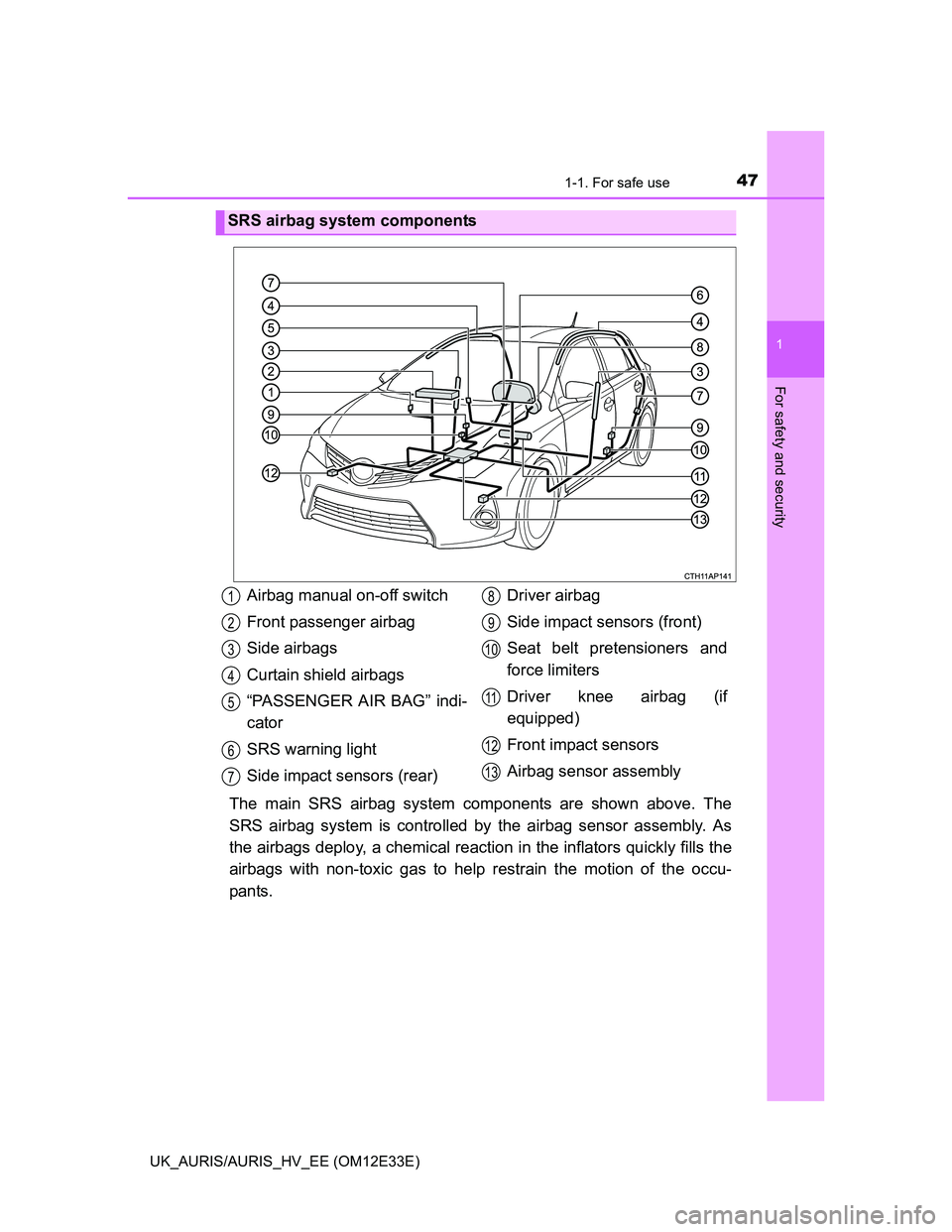
471-1. For safe use
1
For safety and security
UK_AURIS/AURIS_HV_EE (OM12E33E)
The main SRS airbag system components are shown above. The
SRS airbag system is controlled by the airbag sensor assembly. As
the airbags deploy, a chemical reaction in the inflators quickly fills the
airbags with non-toxic gas to help restrain the motion of the occu-
pants.
SRS airbag system components
Airbag manual on-off switch
Front passenger airbag
Side airbags
Curtain shield airbags
“PASSENGER AIR BAG” indi-
cator
SRS warning light
Side impact sensors (rear)Driver airbag
Side impact sensors (front)
Seat belt pretensioners and
force limiters
Driver knee airbag (if
equipped)
Front impact sensors
Airbag sensor assembly1
2
3
4
5
6
7
8
9
10
11
12
13
Page 50 of 750
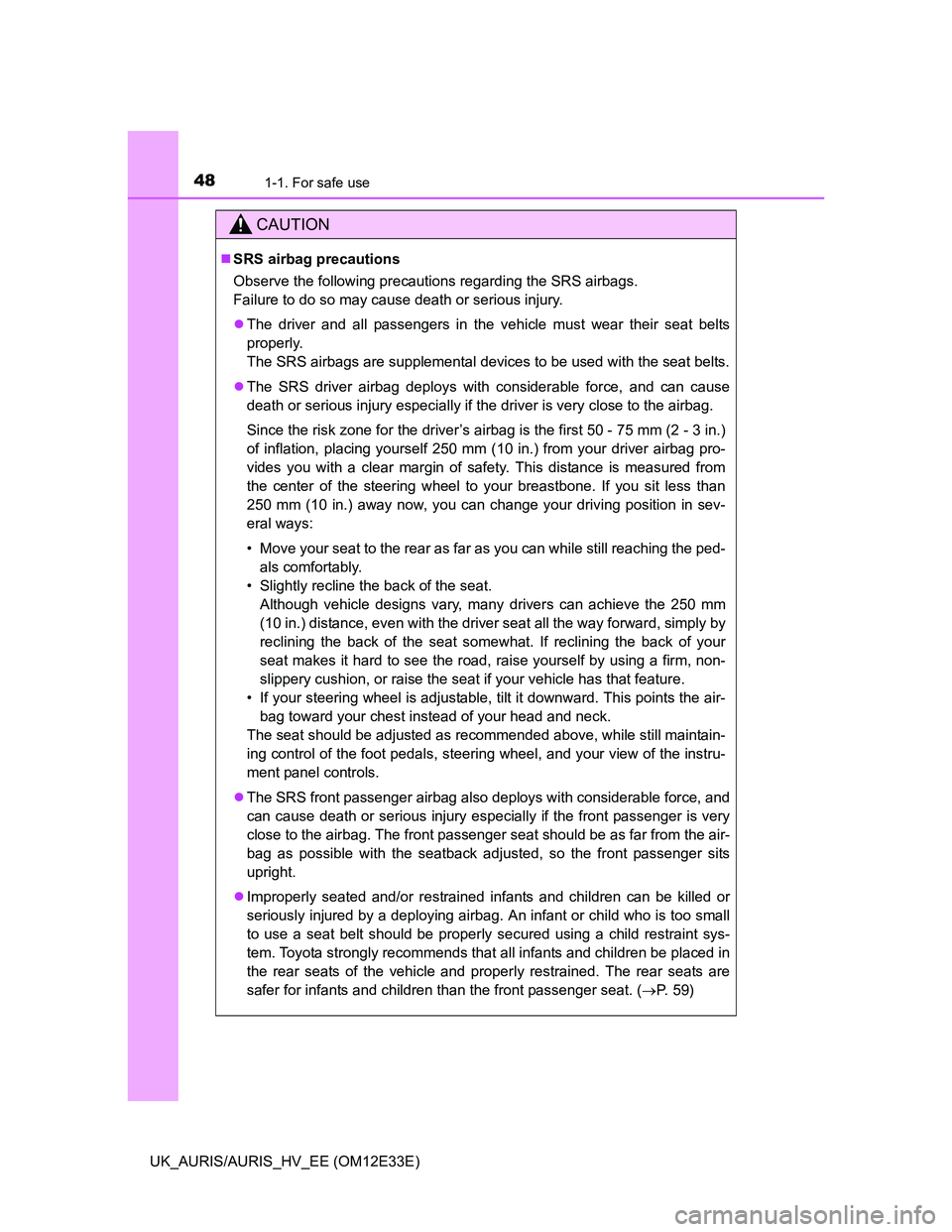
481-1. For safe use
UK_AURIS/AURIS_HV_EE (OM12E33E)
CAUTION
SRS airbag precautions
Observe the following precautions regarding the SRS airbags.
Failure to do so may cause death or serious injury.
The driver and all passengers in the vehicle must wear their seat belts
properly.
The SRS airbags are supplemental devices to be used with the seat belts.
The SRS driver airbag deploys with considerable force, and can cause
death or serious injury especially if the driver is very close to the airbag.
Since the risk zone for the driver’s airbag is the first 50 - 75 mm (2 - 3 in.)
of inflation, placing yourself 250 mm (10 in.) from your driver airbag pro-
vides you with a clear margin of safety. This distance is measured from
the center of the steering wheel to your breastbone. If you sit less than
250 mm (10 in.) away now, you can change your driving position in sev-
eral ways:
• Move your seat to the rear as far as you can while still reaching the ped-
als comfortably.
• Slightly recline the back of the seat.
Although vehicle designs vary, many drivers can achieve the 250 mm
(10 in.) distance, even with the driver seat all the way forward, simply by
reclining the back of the seat somewhat. If reclining the back of your
seat makes it hard to see the road, raise yourself by using a firm, non-
slippery cushion, or raise the seat if your vehicle has that feature.
• If your steering wheel is adjustable, tilt it downward. This points the air-
bag toward your chest instead of your head and neck.
The seat should be adjusted as recommended above, while still maintain-
ing control of the foot pedals, steering wheel, and your view of the instru-
ment panel controls.
The SRS front passenger airbag also deploys with considerable force, and
can cause death or serious injury especially if the front passenger is very
close to the airbag. The front passenger seat should be as far from the air-
bag as possible with the seatback adjusted, so the front passenger sits
upright.
Improperly seated and/or restrained infants and children can be killed or
seriously injured by a deploying airbag. An infant or child who is too small
to use a seat belt should be properly secured using a child restraint sys-
tem. Toyota strongly recommends that all infants and children be placed in
the rear seats of the vehicle and properly restrained. The rear seats are
safer for infants and children than the front passenger seat. (P. 59)